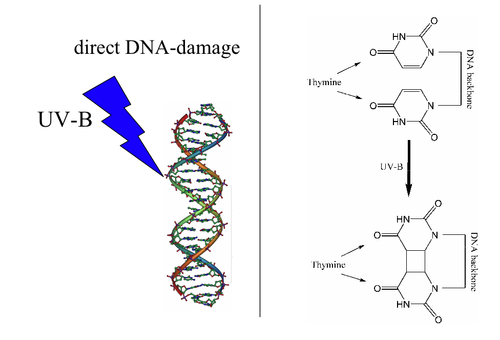Direct DNA damage: Difference between revisions
No edit summary |
No edit summary |
||
| Line 3: | Line 3: | ||
The distinction between '''direct DNA damage''' and [[indirect DNA damage]] is highly relevant for the discussion of UV-induced skin damage, the mechanism of photocarcinogenesis (light induced formation of e.g. Melanoma) and |
The distinction between '''direct DNA damage''' and [[indirect DNA damage]] is highly relevant for the discussion of UV-induced skin damage, the mechanism of photocarcinogenesis (light induced formation of e.g. Melanoma) and |
||
the effect of [[sunscreen]]s. |
the effect of [[sunscreen]]s. |
||
The |
The direct DNA damage can occur when DNA directly absorbs the UV-photon. |
||
Due to the excellent photochemical properties of DNA this nature-made molecule is damaged only by a tiny fraction of the absorbed photons. DNA transforms more than 99.9% of the photons |
Due to the excellent photochemical properties of DNA this nature-made molecule is damaged only by a tiny fraction of the absorbed photons. DNA transforms more than 99.9% of the photons |
||
Revision as of 13:55, 19 February 2008

The distinction between direct DNA damage and indirect DNA damage is highly relevant for the discussion of UV-induced skin damage, the mechanism of photocarcinogenesis (light induced formation of e.g. Melanoma) and the effect of sunscreens. The direct DNA damage can occur when DNA directly absorbs the UV-photon.
Due to the excellent photochemical properties of DNA this nature-made molecule is damaged only by a tiny fraction of the absorbed photons. DNA transforms more than 99.9% of the photons into harmless heat (But the damage from the remaining < 0.1% of the photons is still enough to cause sunburn). The transformation of excitation energy into harmless heat occurs via a photochemical process called internal conversion. In DNA this internal conversion is extremely fast - and therefore efficient. This ultrafast internal conversion is an extremely powerful photoprotection for DNA. It has developed 4 billion years ago, when no oxygen and no ozone was present that could have filtered the UV-light. At the dawn of live the intensity of UV-light was 100 to 1000 times stronger than today and as a consequence all molecules that did not possess this natural photoprotection were destroyed and the favourable photochemical properties of all DNA on this planet are a result of this very first evolutionary selection process.[1]
The absorption spectrum of DNA shows a strong absorption for UVB-radiation and a much lower absorption for UVA-radiation. Since the action spectrum of sunburn is identical to the absorption spectrum of DNA, it is generally accepted that the direct DNA damages are the cause of sunburn. While the human body reacts to direct DNA damages with a painful warning signal, no such warning signal is generated from indirect DNA damage, and the indirect DNA damage is responsible for 92% of all melanoma cases.[2]
genetical analysis and the mechanistic cause of melanoma
The direct DNA damage causes mutations which contain a UV-signature (a rather unfortunate name, since the indirect DNA damage can be caused by UV-radiation as well). These UV-signature mutations can be found in only 8% of all melanoma cases.[2] Thus it can be said that Sunburn (direct DNA damage) is only responsible for a small fraction of all melanoma. 60 years ago - before sunscreen and sunbeds existed - the relative ratio of UVB and UVA could not be manipulated. Furthermore nobody used sunscreen that penetrated into the skin and thereby amplified the amount of free radicals and oxidative stress that a sunscreen-user is exposed to. [3] It can be speculated that 60 years ago the relative importance of the indirect DNA damage and the direct DNA damage was not 92/8. But today the most melanoma do not carry a UV-signature mutation and are therfore caused by the indirect DNA damage.
Please compare to indirect DNA damage.
See also
References
- ^ "ultrafast internal conversion of DNA". Retrieved 2008-02-13.
- ^ a b Davies H.; Bignell G. R.; Cox C.; (2002). "Mutations of the BRAF gene in human cancer". Nature. 417: 949–954.
{{cite journal}}: Unknown parameter|month=ignored (help)CS1 maint: extra punctuation (link) CS1 maint: multiple names: authors list (link) - ^ Hanson Kerry M.; Gratton Enrico; Bardeen Christopher J. (2006). "Sunscreen enhancement of UV-induced reactive oxygen species in the skin". Free Radical Biology and Medicine. 41 (8): 1205–1212.
{{cite journal}}: Cite has empty unknown parameter:|1=(help)CS1 maint: multiple names: authors list (link)
